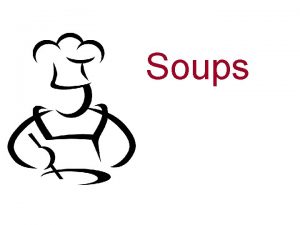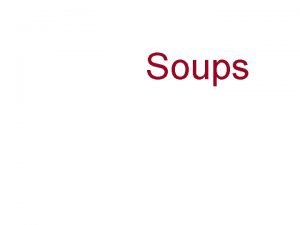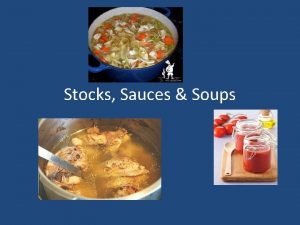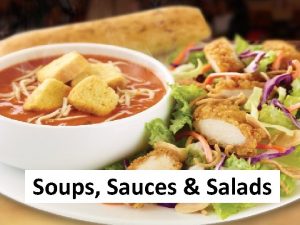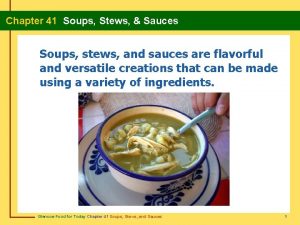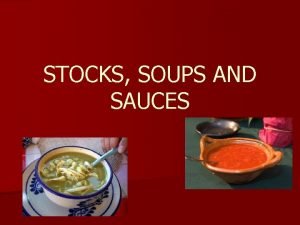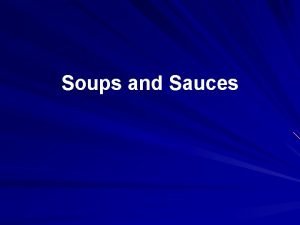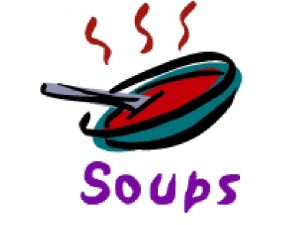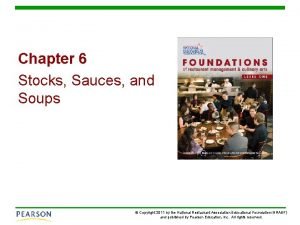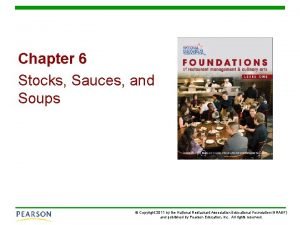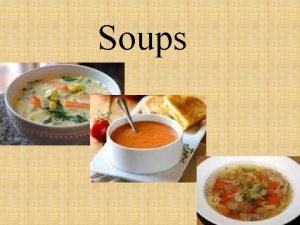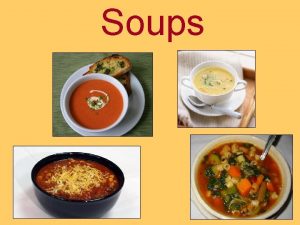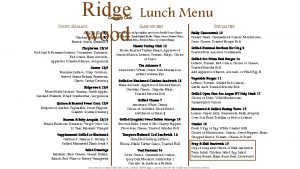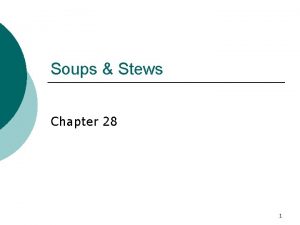Soups SOUP RIDDLE Introduction Soups are served all

































- Slides: 33

Soups

“SOUP RIDDLE”

Introduction: Soups are served all over the world, and they are wonderful time-savers and appetite satisfiers. Soup may be served as an appetizer, to stimulate the appetite, or it may be served as the main dish of the meal. If the soup to be served is a hot soup, it must be served piping hot. If it is to be a cold soup, it must be served icy cold.

There are two main types of soups: • Soups made from meat stock. Meat stock is a broth made by cooking meat with water and it requires long, slow cooking. Beef, veal, lamb or chicken can be cooked separately or in combinations. • Bouillon is a clear soup made from lean beef. • Consomme is a clear soup made from two or three kinds of meat (beef-veal-chicken)

There are two main types of soups: • • • Soups made without meat stock and milk or cream. These soups are called cream soups and have for their basis white sauce. They are made by combining thin white sauce with cooked, mashed or strained vegetable, fish or meat pulp. Bisques are cream soups made with thin white sauce, with fish added or vegetable stock. Chowders are cream soups with pieces of different vegetables, or of fish and potatoes and various seasonings.

Market forms of soups: 1. 2. 3. 4. Canned soups Dried soups Frozen soups Concentrated soups

Market forms of soups: Canned soups • These soups are cooked to obtain the fresh flavor of vegetables and other ingredients that go into them. • They are seasoned most skillfully and made into creamy, satin-smooth mixtures. • They are also used in making casserole dishes, meat loaves, barbecue sauce and molded salads. • There are many excellent canned soups on the market which make quick and delicious soups.

Market forms of soups: Dried soups • The dehydrated package soups have become very popular, and are usually less expensive than some in other forms. • Be guided by the descriptive label. • The label gives the buyer the needed information for cooking the soup and these directions should be studied before beginning to cook - and followed exactly.

Market forms of soups: Frozen soups • Frozen soups are the newest members of the commercial soups. They are now to be found in your grocer’s freezer. • Read the information on the can, for detailed directions for serving are given. • They, too, make quick, and delicious soups.

Market forms of soups: Concentrated soups • These are semi-moist cubes of beef, chicken, or vegetable bouillon. • These cubes are wrapped in foil, and are soluble in boiling water. • Read the information on the label, for detailed directions for serving are given.

Food Value Clear soups are made from stock and have little food value. They are water -- flavored with meat extracts and seasonings. These soups are served at the beginning of the meal to stimulate the appetite, or in the invalid’s diet to provide some nourishment in a form which is easily digested. • Thin, light soups • May be plain liquid – beef or chicken broth – bouillon • May contain vegetables

Clear Soups Whether made from meat poultry vegetables or fish, clear soups are all prepared in a similar manner. They are not difficult to make, but do require patience and attention to achieve a quality product. Broths, consommés, essences, and chilled jellied soups are all types of clear soup.

Clear Soups Broth and bouillon can be used interchangeably and are considered to be among the simplest of soups to make. the flavor of a broth or bouillon comes from simmering the ingredients for a long period of time.

Clear Soups Consommé is a concentrated clear soup, and is the most sophisticated of the clear soups. It is made by reducing then clarifying a veal, beef, chicken, game or fish stock. While ordinary stock is made with bones a consume is enriched with pieces of the chicken veal or beef.

Clear Soups Consommé is a stock or broth that has been clarified to remove impurities so that is crystal clear. It is a fortified stock. The finished consommé will only be as good as the stock or broth from which it was made.

Clear Soups Essences are a derivation of consommés with special flavors. the flavors come from extracts of aromatics, flavorful herbs, plants, vegetables. Or mushrooms. Common extracts would be truffle, asparagus, fennel, tomato or tarragon extract.

Clear Soups • All clear soups start as a stock or broth. Broths are prepared by simmering flavoring ingredients in a liquid for a long time. They are made with meat instead of just bones. • Brown the meat • Add mirepoix to the broth • Strain the broth

Clear Soups • • Mirepoix is a combination of chopped carrots, celery and onions used to add flavor and aroma to stocks, sauces, soups and other foods. The proportions (by weight) for making mirepoix are 50% onions, 25% carrots and 25% celery.

Food Value Hearty or Thick soups • • Contain cooked vegetables, legumes, pasta, meat, poultry, or fish. May be used as a main dish. There are 2 kinds of thick soup: 1. Cream soups are thickened with roux or other starch. 2. Puree soups rely on a puree of the main ingredient for thickening.

Food Value Cream soups are made from milk or cream and contain all of the food nutrients: Proteins and vitamins from the milk. Minerals and vitamins from the vegetables. Carbohydrates from the thickening agent. Fat from the fat used in the white sauce. These are practically all of the body’s requirements in one dish. They fill you up. The food value of soup is also increased by the crackers and bread served with it.

Cream Soups Quality in cream soups is based on: • Thickness The soup should have the consistency of cream or syrup. • Texture The soup should look and feel on the palate of being smooth, creamy and velvety with no lumps. • Taste Should have a distinct yet delicate flavor

Puree Soups • • • purees of starchy vegetables or leguminous the puree of poultry, game , fish, and shellfish are more called coulis. Purees of starchy vegetables or legumes include beans, lentils, split peas, and others. These vegetables have enough starch so the puree will not need anything added to bind it. The secret of good purees is the proper cooking of the ingredients so they can be easily blended. Among the classic purred soups are vichyssoise and leek.

Vegetable Soups • These soups are composed of one or more types of vegetables and usually include onions, leeks and diced bacon, which are first sautéed and then simmered in stock. Flour and potatoes are sometimes used as a binder and most vegetable soups are garnished with chopped parsley, chives, or chervil. • It is important to characterize the vegetables that you are going to use. Those vegetables with stronger or dominant flavors must be used in smaller amounts to ensure a balance and depth of flavor in the soup.

Vegetable Soups For a quality product • Cut the ingredients in uniform shapes and sizes • Braise the vegetables well in the fat or butter • Add liquid and simmer to cook the solid ingredients and concentrate the flavors.

Bisque • Bisques are shellfish soups thickened with cooked rice • created by De La Varenne 1653. • Bisques are usually accompanied with fried croutons.

Chowders are hearty soups with chunks of the main ingredients (including, virtually always, diced potatoes) and a garnish. Chowders contain milk or cream. Chowders are NOT pureed and strained before the cream is added.

Cold Soups Cold soups can be as simple as a chilled version of a cream soup or as creative as a cold fruit soup blended with yogurt.

Side Note Add dry herbs – beginning of cooking. Add fresh herbs – at the end of cooking.

METHOD OF SERVING SOUP 1. Soup dishes are always deep. 2. Soup plates are used for dinner soup. 3. Soup bowls and cups are used for luncheon soups. 4. Set soup dishes on a plate slightly larger than the soup dish. 5. A soup spoon is smaller that a tablespoon and larger that a teaspoon. 6. Bouillon spoons are small roundbowled spoons.

METHOD OF SERVING SOUP 7. In using a soup spoon, dip the spoon away from you. Take the soup silently with the lips from the side of the spoon and not the tip. 8. Do not leave spoon in soup dish. When not using it, place on the plate. 9. When soup is served in a bouillon cup it is customary to take a few spoonfuls and then it is permissible to set the spoon on the plate, and drink the remainder of the soup from the cup. 10. It is permissible to put two or three pieces of crackers or toast on top of soup. NEVER crumble crackers or toast in your soup and then stir it.

GARNISHES FOR SOUPS 1. Croutons - both as a garnish and accompaniment. 2. Grated cheese - sprinkle over top of soup. 3. Thin slices of frankfurters - float on top of soup. 4. Bits of crisp bacon - sprinkle over top of soup. 5. Pop corn - float on top of soup. 6. Parsley, chives, or watercress - cut very finely and sprinkle over top of soup.

QUIZ: 1. There are two main types of soups depending on the main ingredients used. a. Soups made from _____ or liquid from cooked beef, poultry, fish or vegetables. b. Soups made from _____ or _____ are thickened.

QUIZ: 2. Soups served as the main course are called the ________. They contain all of the body’s requirements in one dish and are generally filling. 3. Soups served at the first of the meal are called an ______ and are generally used to_________. They generally contain less food value.
 Antigentest åre
Antigentest åre Serve soup
Serve soup Objectives of riddles
Objectives of riddles Turtle soup riddle
Turtle soup riddle Tigmo tigmo agokoy ugma ra kita mag asoy
Tigmo tigmo agokoy ugma ra kita mag asoy Types of dining experiences
Types of dining experiences Name three lines
Name three lines Introduction for riddles
Introduction for riddles Stocks, sauces and soups
Stocks, sauces and soups Mother sauces
Mother sauces Chapter 6 stocks sauces and soups
Chapter 6 stocks sauces and soups What do soups, stews, and sauces have in common?
What do soups, stews, and sauces have in common? Four parts of a stock
Four parts of a stock Classification of sauces in cooking
Classification of sauces in cooking Classification of soups
Classification of soups Stored sauces and starches in a
Stored sauces and starches in a Chapter 6 stocks sauces and soups
Chapter 6 stocks sauces and soups Chapter 6 stocks sauces and soups
Chapter 6 stocks sauces and soups Chapter 6 stocks sauces and soups
Chapter 6 stocks sauces and soups Chapter 6 stocks sauces and soups
Chapter 6 stocks sauces and soups My very excited mother just
My very excited mother just Period of activism 1970-1972
Period of activism 1970-1972 Modifiers in grammar
Modifiers in grammar David served his generation
David served his generation Small open faced sandwiches served as appetizer
Small open faced sandwiches served as appetizer American service in food and beverage
American service in food and beverage Crew served weapons qualification
Crew served weapons qualification French classical menu in english
French classical menu in english Head heart hand health
Head heart hand health Xm 307
Xm 307 The code of justinian later served as the basis for most
The code of justinian later served as the basis for most The waiter served something that we
The waiter served something that we Animal farm summary
Animal farm summary Female indian slave who served as interpreter for cortés
Female indian slave who served as interpreter for cortés

